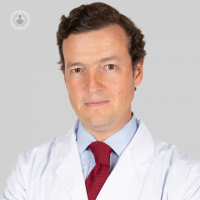The anterior cruciate ligament injuries
Written by:Where is the anterior cruciate ligament located and what function does it fulfill?
The anterior cruciate ligament ( ACL ) is located in the middle of the knee. Its proximal insertion is in the medial aspect of the external femoral condyle and its distal insertion in the anterior part of the tibia. Its main function is to limit the anterior translation of the tibia with respect to the femur and also the internal rotation of the tibia in the last degrees of extension of the knee.

What disorders can suffer?
The main disorder that affects the ACL is breakage. It usually happens in an indirect trauma in which the foot is fixed on the ground (the cleats are stuck firmly during soccer practice or the ski fixation does not jump properly) and the body keeps rotating producing an excessive rotation of the knee that finally breaks the ligament. The rupture produces the phenomenon called "pivot shift", which the patient refers to as a knee failure that prevents him from regaining his level of sport activity due to pain, lack of stability and swelling..
Occasionally partial ligament injuries occur. In these cases, if the stability of the knee is maintained, a conservative treatment can be considered. The stability provided by the ACL to the knee protects the meniscus , so that in chronic lesions a partial meniscus tear is common.. If there is bone edema or associated meniscus injuries, the ligament must be reconstructed and treated.. In cases where there is a partial injury of the symptomatic ligament without associated injuries, a partial reconstruction can be performed, with very good results since part of the tissue has not been damaged.
In what cases should we proceed with its reconstruction? Is it always necessary?
In young and active patients, the reconstruction of the ligament is the best possible treatment. Non-surgical treatment can lead to a high risk of failure episodes that will make sporting impossible. In addition, delaying treatment in patients with instability increases the risk of secondary lesions that worsen the prognosis.
In cases of elderly, sedentary patients who do not present episodes of failure in their daily activities, a non-surgical treatment may be proposed, but they should limit their activities in an important way.
What is the intervention?
The intervention consists in the reconstruction of the LCA. Attempts to repair the ligament by suturing the broken ends are not successful, you have to make a new ligament. For this, different plasties or tissues that can be obtained from the same patient ( autografts ) or from a donor (allografts) are used.. Tunnels are made in the femur or tibia and the ends are fixed with different devices. The current trend is to perform anatomical reconstructions, trying to faithfully reproduce the anatomy of the native LCA.
How long will it take for the patient to recover completely?
Recovery is usually quick. The use of crutches is recommended for 3-4 weeks and prophylaxis is applied with subcutaneous injections of heparin for 10-15 days. In some cases where it is necessary to limit the mobility of the knee, a knee orthosis may be used . Most patients will be able to live a normal life, without physical demand, after about 6 weeks.
For the reincorporation to the sport activity it is necessary more time. After the application of the plasty begins a phase of "ligamentization" of the tissue, whose duration is marked by the biochemical and histological processes that are occurring in the new ligament. During this period of time the resistance of the plasty decreases with respect to the initial one, just after surgery. It is important to keep this in mind given that the process is independent of the recovery of mobility and the subjective feeling that the patient has of his knee. Submit the plasty prematurely to mechanical stresses for which it is not prepared will lead to early failures that will require a second surgery. This will present greater complications and worse functional results. You have to do it once, and do it well.


